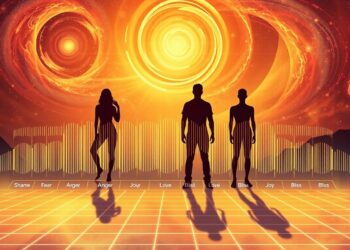Color has a profound impact on human perception and behavior. In the realm of personal branding, understanding the psychology of color is essential for creating a powerful and successful brand identity.
Color symbolism has long been recognized as a crucial element of branding strategy. By strategically leveraging colors, entrepreneurs can evoke specific emotions, build trust, and communicate desired qualities to their target audience.
Color psychology delves into how different colors influence human perception and emotions. Each color carries its own associations and triggers unique responses in individuals.
By harnessing the power of color psychology, entrepreneurs can craft personal brands that stand out and resonate with their audience.
Key Takeaways:
- The psychology of color is a powerful tool in personal branding and marketing.
- Colors evoke specific emotions and associations, making them highly influential in brand perception.
- Understanding color psychology allows entrepreneurs to create branding strategies that align with their target audience and differentiate themselves from competitors.
- Color choices impact brand recognition, trust, and consumer behavior.
- By applying the principles of color psychology, entrepreneurs can create a cohesive and impactful brand identity.
What Is Color Psychology?
Color psychology is the fascinating research field that explores how color influences human behavior and emotions. It delves into the associations and emotions that different colors, hues, and tones evoke in individuals.
Color psychology recognizes that the impact of colors can vary based on personal preferences and cultural influences.
In the realm of marketing, color choices play a pivotal role in shaping how buyers perceive brands and products. Consequently, it is crucial for businesses to carefully select colors that align with their business goals and target audience.
“Color psychology goes beyond mere aesthetics. It delves into the intricate relationship between color and human psychology, unlocking insightful cues that can be leveraged to drive desired consumer behavior.”
By understanding color psychology, businesses can strategically utilize colors to create strong emotional connections with their target audience.
Whether it’s conveying trust, excitement, or serenity, the right color choices can amplify the impact of their marketing efforts and solidify their brand identity.
Take a moment to reflect on how colors have influenced your own emotions and perceptions. Imagine walking into a bright, vibrant store with vivid reds and oranges that evoke energy and excitement.
Now, picture yourself in a peaceful, calming space with subdued blues and greens that promote relaxation and tranquility. These examples showcase the power of color associations and how they can shape our experiences.
Whether you’re designing a new logo, developing a website, or planning a marketing campaign, understanding color psychology can significantly impact the success of your business.
By strategically selecting colors that resonate with your target audience and align with your business goals, you can create a visual brand identity that leaves a lasting impression.
Now, let’s take a closer look at some of the common color associations and the emotions they evoke:
| Color | Emotions and Associations |
|---|---|
| Blue | Calmness, trust, reliability |
| Red | Excitement, power, passion |
| Green | Relaxation, health, prosperity |
| Purple | Royalty, wealth, sophistication |
| Orange | Confidence, creativity, courage |
| Yellow | Youthfulness, happiness, optimism |
| Black | Sophistication, power |
| White | Cleanliness, modernity |
| Pink | Femininity, youthfulness |
The color associations listed above are just a glimpse of the rich tapestry of emotions that different colors can evoke.
By carefully considering the psychology behind each color and its impact on human emotions, businesses can create powerful branding strategies to connect with their target audience on a deep and meaningful level.
With the knowledge of color psychology in your arsenal, you have the ability to elevate your branding and marketing efforts to new heights.
Understanding how colors impact human behavior and emotions allows you to align your choices with your business goals and target audience, fostering a deeper connection and driving desired consumer actions.
How Entrepreneurs Use Color Psychology
Color psychology holds immense power in shaping consumers’ first impressions of a brand or product. The specific colors associated with a brand can greatly influence how consumers perceive it. In fact, research indicates that up to 90% of initial impressions are based on color alone.
For entrepreneurs, understanding the impact of color psychology is crucial in creating effective branding strategies that resonate with their target audience and drive purchasing decisions.
Studies have shown that the strategic utilization of color can significantly increase brand awareness and recognition by up to 80%. This means that entrepreneurs have the opportunity to enhance their brand’s visibility and establish a strong presence simply by leveraging color psychology.
By selecting and incorporating the right colors into their branding efforts, entrepreneurs can convey desired messages and evoke specific emotions in consumers.
The Power of Color in Branding
Color plays a vital role in shaping consumer perception of a brand. Different colors evoke different emotions and associations, allowing entrepreneurs to create a distinct and memorable brand identity. Here are some examples of how color influences consumer perception:
| Color | Associations |
|---|---|
| Blue | Security, trust, reliability |
| Red | Excitement, power, passion |
| Green | Relaxation, health, prosperity |
| Purple | Royalty, wealth, sophistication |
| Orange | Confidence, creativity, courage |
| Yellow | Youthfulness, happiness, optimism |
| Black | Sophistication, power |
| White | Cleanliness, modernity |
| Pink | Femininity, youthfulness |
Understanding the psychological associations behind each color empowers entrepreneurs to strategically select the colors that align with their brand attributes and objectives.
By harnessing the power of color, entrepreneurs can effectively communicate their brand message and create a strong emotional connection with their target audience.
Creating Brand Identity through Color
When choosing brand colors, it is essential for entrepreneurs to consider the emotions and associations they evoke. Authenticity is key in personal branding, so entrepreneurs should identify their own unique brand traits and select a color that aligns with those traits.
By incorporating the chosen color consistently across all digital and physical brand elements, entrepreneurs reinforce their brand message and enhance brand recognition.
It is also beneficial to integrate the brand color into personal style and accessories. This not only strengthens brand recognition but also adds a personal touch, making the brand more relatable and memorable.
To summarize, color psychology is a powerful tool that entrepreneurs can use to shape consumer perception, drive purchasing decisions, and create a distinct brand identity.
By understanding how colors influence emotions and associations, entrepreneurs can strategically select and utilize colors that resonate with their target audience. Harnessing the psychology of color empowers entrepreneurs to build strong brand awareness, recognition, and success.
Color Breakdowns
Understanding the psychological effects of different colors is essential when it comes to personal branding and marketing. Each color has a unique influence on consumer perception and can evoke various emotions.
Let’s delve into the breakdown of some of the most prominent colors and the associations they commonly elicit.
Blue
Blue is often associated with feelings of security, strength, wisdom, and trust. This color is widely used in branding, with approximately 33% of top brands incorporating blue into their logos. Its calming effect makes it an ideal choice for businesses that aim to establish credibility and convey a sense of reliability.
Red
Red is a color that exudes excitement, energy, power, and passion. Its stimulating nature can also make people feel hungry, making it an impactful choice for call-to-action buttons or food-related industries. Incorporating red into branding can help create a sense of urgency and grab attention.
Green
Green symbolizes relaxation, health, prosperity, and freshness. It is often associated with nature and the environment. Brands that focus on sustainability, wellness, and growth can effectively leverage green to connect with their target audience and emphasize their values.
Purple
Purple is a color that represents royalty, wealth, and sophistication. It is often used to convey elegance and luxury. Brands that aim to exude a sense of ambition, creativity, and exclusivity may incorporate purple into their visual branding elements to attract their desired audience.
Orange
Orange is a color that evokes confidence, creativity, and courage. It can also be associated with vibrancy and playfulness. While it can appeal to certain segments of the market, it may come across as immature to others.
Brands targeting a young and energetic demographic often use orange to convey a sense of enthusiasm.
Yellow
Yellow represents youthfulness, happiness, and optimism. It is a vibrant and attention-grabbing color. While it can evoke positive emotions, yellow may also foster feelings of anxiety and fear in some individuals.
Brands that want to exude a fresh and cheerful image can incorporate yellow into their branding strategy.
Black
Black is a color that evokes sophistication, power, and elegance. It conveys a sense of professionalism and authority. Brands that aim to create a sleek and modern image often use black in their visual identity to create a sense of luxury and exclusivity.
White
White is a color that represents purity, cleanliness, and simplicity. It gives a clean and modern look to brands. Many technology companies and healthcare providers use white extensively in their branding to communicate a sense of clarity and efficiency.
Pink
Pink is often associated with femininity and youthfulness. It can evoke feelings of warmth and tenderness. However, depending on its application, pink may also generate a sense of immaturity or rebellion.
Brands targeting a young and feminine audience may incorporate pink into their visual branding to create a more relatable image.
| Color | Meaning | Associations |
|---|---|---|
| Blue | Security, strength, wisdom, trust | Reliability, credibility, calmness |
| Red | Excitement, energy, power, passion | Attention, urgency, hunger |
| Green | Relaxation, health, prosperity, freshness | Nature, growth, balance |
| Purple | Royalty, wealth, sophistication | Elegance, luxury, ambition |
| Orange | Confidence, creativity, courage | Vibrancy, playfulness, enthusiasm |
| Yellow | Youthfulness, happiness, optimism | Cheerfulness, energy, anxiety |
| Black | Sophistication, power, elegance | Authority, luxury, exclusivity |
| White | Purity, cleanliness, simplicity | Clarity, efficiency, modernity |
| Pink | Femininity, youthfulness | Tenderness, warmth, relatability |
How Color Psychology Impacts Branding and Marketing
Color psychology plays a significant role in branding and marketing, influencing various aspects of consumer behavior and purchasing decisions.
By understanding the emotional impact and associations that different colors hold, entrepreneurs can strategically shape brand perception and create stronger connections with their audience.
Brand recognition is heavily influenced by color choices. Studies show that 90% of initial brand assessments are based on color alone. Consistency in using specific colors across brand elements enhances brand recognition and creates a cohesive identity.
When consumers consistently associate a particular color with your brand, it becomes a powerful tool in building brand awareness and recall.
“Color is a power which directly influences the soul.” – Wassily Kandinsky
Furthermore, color psychology has a profound impact on consumer emotions and behavior. Different colors evoke distinct emotional responses, ranging from trust and serenity to excitement and energy.
Entrepreneurs can leverage this knowledge to create targeted emotional connections with their audience. By strategically selecting and incorporating colors that align with the desired brand perception, businesses can influence consumer emotions and drive purchasing decisions.
| Color | Emotional Associations |
|---|---|
| Blue | Security, trust, wisdom |
| Red | Excitement, power, passion |
| Green | Relaxation, health, prosperity |
| Purple | Royalty, wealth, sophistication |
| Orange | Confidence, creativity, courage |
| Yellow | Youthfulness, happiness, optimism |
| Black | Sophistication, power |
| White | Cleanliness, modernity |
| Pink | Femininity, youthfulness |
The Emotional Associations of Popular Colors
- Blue: Conveys a sense of security, strength, and trust. It is often used by brands to establish credibility and reliability.
- Red: Evokes excitement, intensity, and passion. It can create a sense of urgency and is frequently utilized in marketing campaigns or call-to-action buttons.
- Green: Symbolizes relaxation, freshness, and prosperity. It is commonly associated with natural and organic products.
- Purple: Represents luxury, elegance, and creativity. It appeals to audiences seeking sophistication and uniqueness.
- Orange: Conveys energy, enthusiasm, and playfulness. It is often used by brands that want to stand out and captivate attention.
- Yellow: Symbolizes optimism, happiness, and youthfulness. It is used to create a cheerful and inviting atmosphere.
- Black: Evokes sophistication, power, and authority. It is commonly used to create a sense of exclusivity and luxury.
- White: Represents purity, cleanliness, and simplicity. It is often used to convey a modern and minimalistic aesthetic.
- Pink: Associated with femininity, youthfulness, and romance. It is commonly used in industries targeting a female audience.

The strategic use of color in branding and marketing allows entrepreneurs to tap into the psychology of consumer perception and behavior.
By making informed color choices that align with their brand’s values and target audience, businesses can enhance brand recognition, shape brand perception, and create an emotional impact that drives consumer decision-making.
The Psychology of 12 Popular Colors
Different colors elicit various emotions and have distinct associations. Understanding the psychology of popular colors can help entrepreneurs make informed decisions about their branding and marketing strategies.
When choosing colors for your brand, it’s important to consider the emotions and messages that each color conveys. Let’s explore the psychology behind some of the most popular colors and how they can influence your audience:
1. Red
Red is emotionally charged and can evoke feelings of power, passion, and excitement. It grabs attention and stimulates the senses, making it a popular choice for call-to-action buttons and sales promotions.
2. Blue
Blue is calming and associated with trust, reliability, and stability. It represents loyalty and can create a sense of security. Many financial institutions and technology companies use blue in their branding to convey professionalism and dependability.
3. Yellow
Yellow is cheerful, optimistic, and energizing. It grabs attention and creates a sense of happiness and positivity. This color is often used in the food industry to stimulate appetite and convey a sense of freshness.
4. Green
Green represents growth, nature, and relaxation. It is associated with health, freshness, and eco-friendliness. Many brands in the health and wellness industry use green to convey a sense of well-being and sustainability.
5. Orange
Orange is energetic, creative, and courageous. It grabs attention and exudes enthusiasm and confidence. Orange is commonly used by brands in the entertainment and sports industries to create excitement and encourage action.
6. Purple
Purple conveys sophistication, luxury, and ambition. It is often associated with creativity and uniqueness. Many beauty and fashion brands use purple to create a sense of elegance and individuality.
7. Black
Black is often associated with sophistication, power, and authority. It represents elegance and timelessness. Many luxury brands use black in their branding to create a sense of exclusivity and prestige.
8. White
White gives a clean and modern look. It is associated with purity, simplicity, and innocence. Many technology and healthcare brands use white in their branding to convey cleanliness and clarity.
9. Pink
Pink is often associated with femininity, love, and youthfulness. It can create a sense of playfulness and romance. Many beauty and fashion brands target a female audience and use pink in their branding to appeal to their target demographic.
10. Brown
Brown represents stability, reliability, and earthiness. It is often associated with the outdoors and natural products. Many food and beverage brands use brown in their branding to convey a sense of warmth and natural ingredients.
11. Gray
Gray is neutral, practical, and timeless. It represents balance and sophistication. Many technology and automotive brands use gray in their branding to create a sense of professionalism and sleekness.
12. Gold
Gold represents luxury, wealth, and success. It is associated with prestige and exclusivity. Many high-end brands use gold in their branding to create a sense of opulence and elegance.
By choosing colors that align with your brand attributes and objectives, you can effectively communicate your message and connect with your target audience on a deeper level.
Remember that color perception can vary across cultures, so it’s important to research and understand your target market’s cultural associations with different colors.
Tips for Picking Your Brand Colors
When it comes to branding, the colors you choose have a significant impact on how your audience perceives your personal brand. The emotions and associations that colors evoke can shape the way people connect with and remember your brand.
To ensure that you make the right choices, consider the following tips:
- Identify Your Authentic Personal Brand Traits: Start by identifying the key traits that define your personal brand. Are you bold and adventurous, or calm and trustworthy? Knowing your brand personality will help you select colors that align with your unique identity.
- Select a Color That Aligns with Your Brand Traits: Once you have identified your brand traits, choose a color that reflects those qualities. For example, if you want to convey trustworthiness, consider using blue, as it is often associated with reliability and stability.
- Choose One Dominant Color: To create consistency and establish a strong brand identity, it’s essential to select one dominant color. This color will be the primary representation of your brand and will help people quickly recognize and remember your personal brand.
- Apply Brand Color Consistently: To reinforce your brand message and increase memorability, apply your chosen brand color consistently across all digital and real-world brand elements. This includes your website, social media profiles, business cards, and other physical items.
- Integrate Brand Color into Personal Style: Go the extra mile to enhance brand recognition and differentiation by incorporating your brand color into your personal style and accessories. This can include clothing choices, jewelry, and even the colors used in your workspace.
By following these tips, you can select brand colors that not only resonate with your target audience but also create a strong and memorable personal brand identity.

The use of color in branding is powerful and can have a lasting impact on how people perceive your personal brand.
By carefully selecting your brand colors and consistently applying them across all touchpoints, you can create a memorable and visually appealing brand that stands out from the competition.
Conclusion
Color psychology is a powerful tool in personal branding, allowing individuals to create a strong brand identity and emotional connection with their audience.
By understanding the psychology behind colors and strategically applying them, entrepreneurs can communicate their brand attributes and influence consumer perception.
Colors have the ability to evoke specific emotions and associations, making them a vital component of branding. Consistently utilizing the right colors can enhance brand recognition, memorability, and ultimately contribute to success.
Whether it’s the calming and trustworthy nature of blue, the energetic and creative vibe of orange, or the sophistication conveyed by purple, choosing the right color can make a significant impact on personal branding.
By aligning color choices with brand attributes and objectives, entrepreneurs can effectively convey their brand message and resonate with their target audience.
Remember, personal branding is not just about the products or services you offer; it’s about creating a meaningful and authentic connection with your audience.
Harnessing the power of color psychology enables you to establish a strong brand identity and foster an emotional connection that sets your personal brand apart from the competition.
FAQ
What is color psychology?
Color psychology is the study of how different colors impact human behavior and emotions. It explores the associations and emotions that different colors, hues, and tones evoke.
How do entrepreneurs use color psychology?
Entrepreneurs use color psychology to shape consumer perception, create effective branding strategies, and drive purchasing decisions.
What are some popular colors and their associations?
Blue is associated with trust and wisdom, red with power and passion, green with relaxation and prosperity, purple with royalty and sophistication, orange with confidence and creativity, yellow with happiness and optimism, black with sophistication and power, white with cleanliness and modernity, and pink with femininity and youthfulness.
How does color psychology impact branding and marketing?
Color psychology can influence brand recognition, shape brand perception, and create emotional connections with consumers, ultimately driving consumer behavior and purchasing decisions.
What is the psychology behind 12 popular colors?
The psychology behind popular colors reveals that red evokes power and excitement, blue conveys trust and reliability, yellow signifies optimism and energy, green represents growth and nature, orange suggests courage and creativity, purple symbolizes sophistication and ambition, and pink is associated with femininity and youthfulness.
What are some tips for picking brand colors?
When selecting brand colors, entrepreneurs should consider the emotions and associations they evoke, choose colors that align with their brand attributes, and apply the colors consistently across all brand elements to reinforce the brand message and enhance recognition.
How does color psychology impact personal branding?
Color psychology plays a crucial role in personal branding, helping individuals create a strong brand identity and emotional connection with their audience, ultimately contributing to their success.




























































